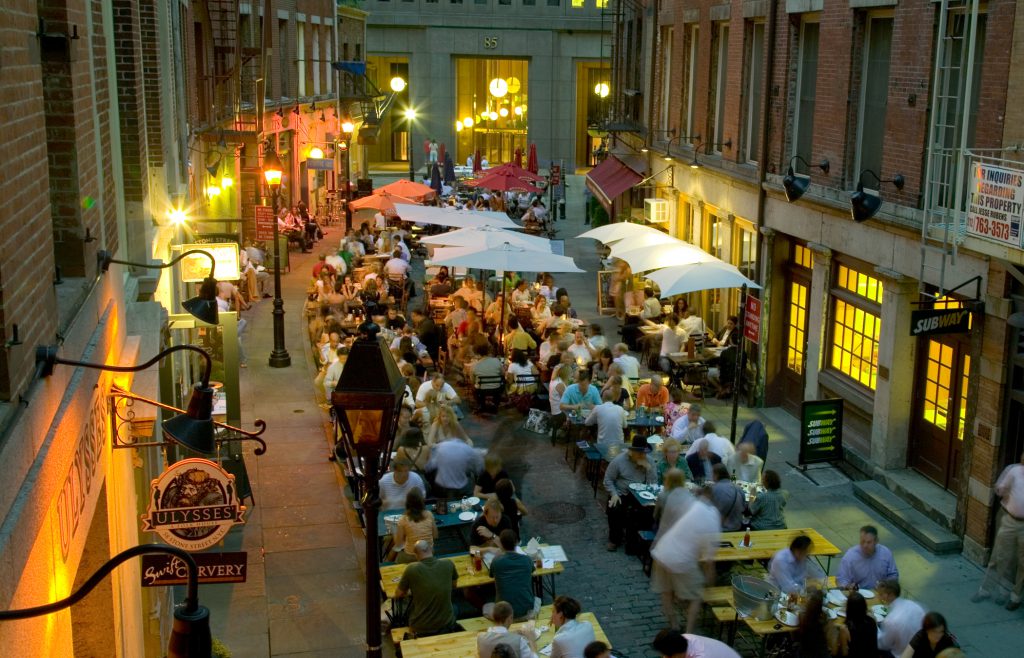Back to the Future For the Financial District

By Liz Berger
Our mission at the Alliance for Downtown New York is to advance Lower Manhattan as a global model for a 21st century central business district, a compelling place to work, live and visit. This objective contemplates the future as well as the past, because for much of the last 400 years our community has been both commercial and residential. Though the canyons of 20th century Wall Street were business-only, the Financial District first took shape in the 1700s as securities traders who lived in the neighborhood met to make deals under a buttonwood tree near what is now 68 Wall.
So it’s back to the future for the Financial District. I’ve been proud to witness firsthand its most recent resurgence—as New York City’s premier live/work community. The transition from business-only to business-plus was just starting when I moved below Fulton Street in 1982.
The neighborhood was starkly different then. In fact, it wasn’t yet a neighborhood, or hadn’t been one for more than a century. Wall Street was the world’s best-known business address, which meant lots of action during business hours but not much in the evenings or on weekends. Though 10,000 of us lived below Chambers Street, there was only one all-night diner, and forget about buying a quart of milk after hours.
But we loved life on the cusp of New York City’s past, present and future. No supermarket? We lugged our groceries home on the subway. No chic Saturday night bistro? We dined in. No gift shop? We found great things at J&R, Century 21, Brooks Brothers, Dick’s Hardware and the Nassau Street specialty stores memorialized by Red Grooms in Ruckus Manhattan. The adventure was worth the challenge of being pioneers.
Slowly, then all of a sudden, things changed. The Financial District remains a prime business address, but it has also become a hot residential neighborhood. New restaurants and markets opened, and old ones expanded their hours. The past 10 years, especially, have brought a dizzying array of companies, merchants, schools and parks—and a new generation of people who call this part of Lower Manhattan home. Nowhere is this more evident than on Wall Street itself, home to some of the world’s most prominent financial institutions but also to thousands of residents, more than a dozen new retailers and a museum.
In other words, Lower Manhattan has become a community, a place that hosted nine million visitors last year alone and where 309,000 people work and 56,000 live together. There is a powerful commonality of spirit and interest, the shared belief that, here in Lower Manhattan, Wall Street and Main Street are the same street.
This was obvious when the Community Board 1 Financial District Committee recently considered a proposal to open a methadone clinic on Maiden Lane. The proponents must have been surprised to learn that 20,000 people live within four blocks of the proposed location and that there are four primary and elementary schools within the same radius. Led by Assembly Speaker Sheldon Silver, a group of property owners, small-business people and residents made the case that this is not your father’s week-day Wall Street but the heart of a 24/7 residential and commercial district. The application was withdrawn.
As Speaker Silver often says, Lower Manhattan is a great place to live, work and raise a family. Nowhere is this truer than in the Financial District. No longer Manhattan’s post-modern frontier, Lower Manhattan gets better and better as more companies, more nonprofits, more entrepreneurs, more open space, more hotels, more restaurants, more stores and more people combine to make it New York City’s most dynamic place to work, live and visit.
Liz Berger is President of the Downtown Alliance
Tags: Brooks Brothers, Century 21, Dick’s Hardware, J&R Music and Computer World, Liz Berger, Lower Manhattan, Red Grooms, Ruckus Manhattan, Sheldon Silver


